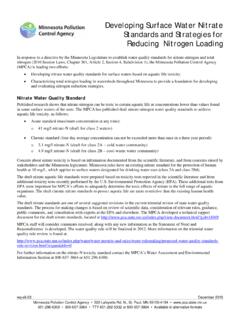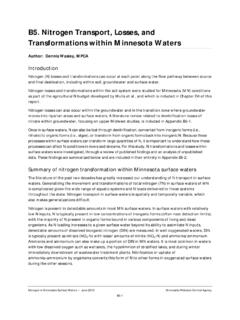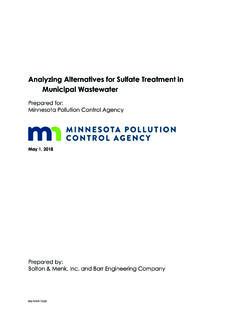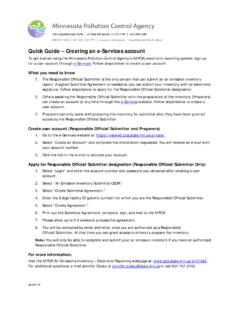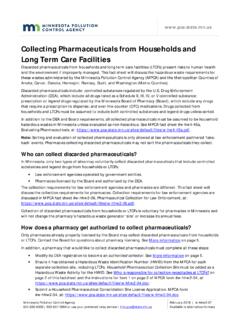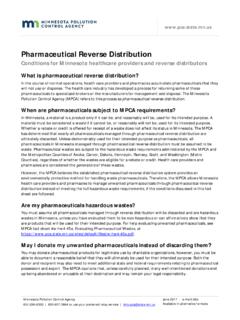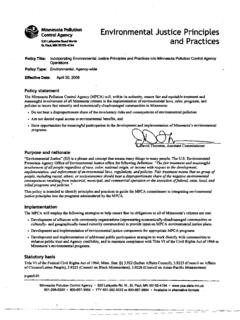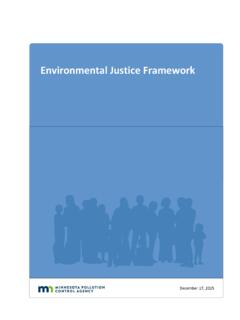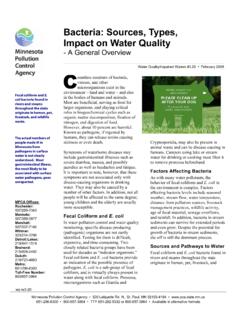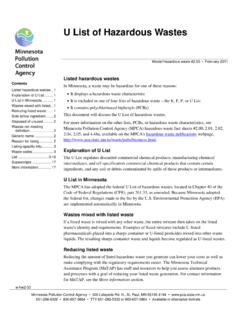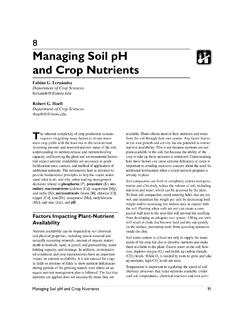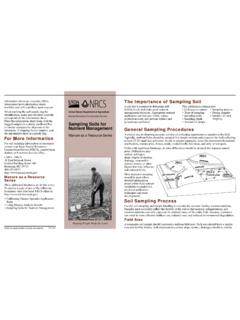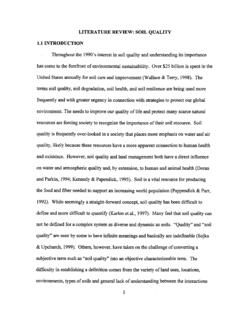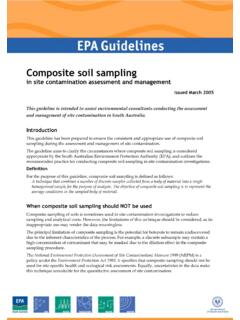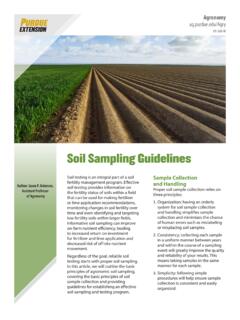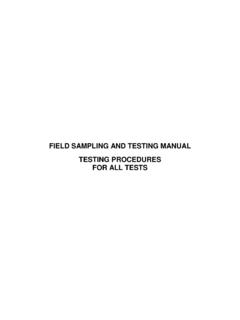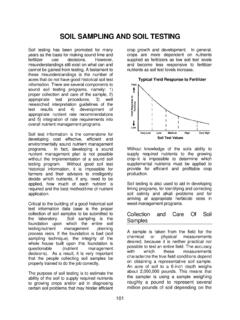Transcription of Soil Sample Collection and Analysis Procedures
1 soil Sample Collection and Analysis Procedures Petroleum Remediation Program This document describes the Procedures for field screening of petroleum-contaminated soil and Collection of soil samples for laboratory Analysis . The Minnesota Pollution Control Agency (MPCA) Petroleum Remediation Program (PRP) conducts random on- site audits of fieldwork. Give the PRPat least 48 hours' notice prior to conducting fieldwork at sites under program oversight. Find information on the fieldwork notification process at Prior notification of fieldwork is mandatory and will be verified upon submittal of the results. To assure data quality, the Environmental Protection Agency (EPA) has required the MPCA to develop a Quality Assurance Program Plan (QAPP) for the PRP. The objective of the QAPP is to define the Quality Assurance/Quality Control (QA/QC) Procedures to be followed for the Collection and Analysis of environmental samples.
2 This ensures sufficient precision and accuracy of samples used in the PRP. I. Field screening Procedures A. soil headspace screening Use the polyethylene bag headspace method described below to characterize soil contamination at petroleum release sites. 1. Use photoionization detectors (PIDs) with a eV (+/-) or greater lamp source. Perform PID instrument calibration on site and at least daily to yield "total organic vapors" in parts per million by volume of a benzene equivalent. Follow the manufacturer's instructions for operation, maintenance, and calibration of the instrument. Keep calibration records in a bound book. MPCA staff reserve the right to request these records. 2. Use a resealable one-quart polyethylene freezer bag. Half-fill the bag with Sample (the volume ratio of soil to air is equal), then immediately seal it.
3 Manually break up the soil clumps within the bag. Note: Immediately after opening the split spoon sampler or soil Sample liner, transfer soil to field screening bags. Collect soil samples from excavations or soil stockpiles from freshly exposed surfaces. 3. Allow headspace development for at least 10 minutes at approximate room temperature. Vigorously shake bags for 15 seconds at the beginning and end of the headspace development period. Headspace development decreases with temperature. When temperatures are below the operating range of the instrument, perform headspace development and screening in a heated vehicle or building. Record the ambient temperature during headspace screening. Complete headspace screening within approximately 20. minutes of Sample Collection . 4. After headspace development, introduce the instrument sampling probe through a small opening in the bag to a point about one-half of the headspace depth.
4 Keep the probe free of water droplets and soil particles. 5. Record the highest meter response on a sampling form. Maximum response usually occurs within about two seconds. Erratic meter response may occur if high organic vapor concentrations or moisture is present. Note any erratic headspace data in the sampling form. Do not collect analytical samples from the polyethylene bag. Minnesota Pollution Control Agency January 2021 | c-prp4-04. 651-296-6300 | 800-657-3864 or use your preferred relay service | Available in alternative formats . B. Petroleum sheen test The petroleum sheen test is a quick and easy field method used to determine if a soil Sample is considered petroleum saturated. A soil is defined as petroleum-saturated when pore spaces contain some petroleum light non-aqueous phase liquid (LNAPL), with the remainder occupied by air and/or water.
5 Detection of sheen or droplets of product when conducting this test is direct evidence that LNAPL is present and the soil Sample is petroleum saturated. 1. Place a small quantity of petroleum-contaminated soil in a jar or on a large spoon. Alternatively, use the soil in the polyethylene bag after measuring the soil headspace described above. 2. Add enough water to break apart and submerge the soil particles. Add water directly to the polyethylene bag if using soil from headspace screening. Let the Sample rest for a minimum of 10 minutes prior to examining for sheen or droplets of product. 3. If droplets of product or sheen are present on the water surface, the test result is positive and the soil is considered petroleum saturated. II. soil sampling Procedures A. soil sampling - site characterization for investigation purposes 1.
6 Minimize the possibility of cross-contamination by using disposable sampling equipment that is certified as clean for each Sample collected. If disposable sampling tools are not available, specify the cleaning Procedures used. Wear clean sampling gloves at each sampling point. When using a split-spoon or similar sampler, wash it with a detergent solution ( , Liquinox or equivalent), and rinse before each use. 2. When sampling excavation sidewalls or floors, remove at least one foot of exposed soil prior to collecting the Sample to ensure Collection of a fresh Sample . See Excavation of petroleum contaminated soil for sampling requirements. 3. Collect samples from split-spoon samplers or soil Sample liners using a procedure that will minimize losses due to volatilization. Collect samples as soon as possible after the surface of the soil has been exposed to the atmosphere.
7 Do not collect analytical samples from soil cores that have been exposed for more than a few minutes. In order to allow for Sample selection based on field screening results, immediately transfer an undisturbed portion of the soil coreto a resealable one-quart polyethylene freezer bag, sealed with no headspace, and placed on ice in a cooler. After the sampling interval has been determined, collect the analytical samplefrom the undisturbed bagged core Sample . Complete Sample containerization and preservation within two hours of retrieving the core from the subsurface. Document the procedure in the Investigation report. See soil and groundwater assessments performed during site investigations for sampling requirements. 4. EPA Method 5035 is required when sampling soil for volatile contaminants per EPA SW-846. Collect soil samples using coring devices ( , cut syringe, EnCoreTM , or US Analytical's Eazydraw SyringeTM sampler, or other approved coring device) and either put the "cored" soil directly into containers provided by the analytical laboratory (verify that the laboratory has pre-weighed these containers) or place the sealed coring device (for an EnCoreTM type sampler) containing the soil in a cooler containing ice.
8 The correct volume of soil to use in the coring device is established by weighing a similar soil Sample before coring the analytical Sample . Do not weigh analytical Sample into the Sample container because doing so can undesirably aerate the soil Sample . The holding time is 14 days for soil samples preserved by methanol or frozen in an approved coring device. Samples in a coring device that are not frozen must be extracted within 48 hours. Do not retain soil previously used for field screening or soil classification for analytical samples. a) Gasoline range organics (GRO) and volatile organic compound (VOC) sampling : Collect GRO and VOC. samples according to the Wisconsin Department of Natural Resources Modified GRO method and EPA. Method 5035, respectively. These methods require the use of methanol as a preservative for most Page 2 of 12 January 2021 | c-prp4-04.
9 sampling . When methanol is used as the preservative, GRO and VOC results can be obtained from the same Sample . Preserve approximately 25 grams of soilwith 25 ml of methanol in a tared 60-ml vial. A. maximum of 35 grams of soil is recommended to enable a 1:1 ratio of soil to extraction solvent in the Sample container. Other Sample sizes, such as 5 grams of soil and 5 mL of methanol in a 40-mL VOC vial, can be utilized if the 1:1 ratio is maintained. An approved sampler ( , EnCoreTM or similar certified sampler) can also be used to hold the samples for 48 hours from the time of Collection when held at 4 . 2 degrees Celsius, or 14 days from the Collection date when frozen below -12 degrees Celsius, before methanol preservation. A dry weight vial without methanol preservation is also required for every Sample . Clean the vial threads to assure a good seal with the cap provided.
10 B) Diesel range organics (DRO) sampling : Collect DRO samples according to the Wisconsin Department of Natural Resources Modified DRO method. Place approximately 25 grams of soil in a tared 60-ml vial without preservative. A maximum of 35 grams of soil is recommended to enable a 1:1 ratio of soil to extraction solvent in the Sample container. An approved sampler can also be used to hold the Sample until it is extracted following the Wisconsin DRO protocols. Collect another vial for dry weight determination on the Sample . Clean the vial threads to assure a good seal with the cap provided. Add methylene chloride to the DRO samples within 10 days. The laboratory must complete the extraction process and Sample Analysis within 47 days of Collection . 5. Label all vials, place in a covered cooler with ice, and transport to the laboratory for Analysis .
